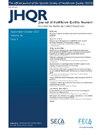坚持服用口服抗糖尿病药物与控制 2 型糖尿病之间的关系。
IF 1
Q4 HEALTH CARE SCIENCES & SERVICES
引用次数: 0
摘要
导言和目标:口服抗糖尿病药物(Adh-OAD)依从性差是 2 型糖尿病(T2DM)控制不佳的一个风险因素。因此,有必要对 Adh-OAD 进行量化。通过社区药房的电子配药记录可以进行量化。目的是评估 Adh-OAD 对 T2DM 控制和患者糖化血红蛋白百分比(%HbA1c)的影响:在格拉纳达(西班牙)的 8 家社区药房开展了一项横断面描述性观察研究。研究对象包括 18 岁以上的 T2DM 患者,这些患者至少服用过 6 个月的口服抗糖尿病药物 (OAD)。研究的主要变量是 T2DM 控制率、血红蛋白 A1c 百分比和 Adh-OAD,考虑了三个截断点(≥80%、≥70%、≥60%)。分别采用多变量二元逻辑回归和多变量线性回归对这一关系进行了研究:共纳入 107 名患者。平均年龄为 70.5 岁(SD:9.7),54.2% 为男性。85名患者(79.4%)的 T2DM 控制良好(平均 HbA1c 百分比:6.5%;SD=0.6)。考虑到 Adh-OAD≥80% 的患者,13.1%(14 人)的依从性较差,这与 HbA1c%(β=0.742;P=0.007)和 T2DM 控制情况(OR:7.327;95% CI:1.302-41.241)有关。Adh-OAD≥70% 的患者中有 9.3%(10 人)依从性较差,Adh-OAD≥60% 的患者中有 3.7%(4 人)依从性较差。在这两种情况下,均发现 Adh-OAD 与 HbA1c 百分比之间以及 Adh-OAD 与 T2DM 控制率之间存在显著的统计学关系:结论:Adh-OAD对T2DM患者的血红蛋白A1c%及其病情控制有影响。本文章由计算机程序翻译,如有差异,请以英文原文为准。
Relationship between adherence to oral antidiabetic drugs and control of type 2 diabetes mellitus
Introduction and objectives
Poor adherence to oral antidiabetic drugs (Adh-OAD) is a risk factor for poor control of type 2 diabetes mellitus (T2DM). Therefore, it is necessary to quantify the Adh-OAD. This quantification is possible through electronic dispensing records from the community pharmacy.
The objective was to evaluate the influence of the Adh-OAD on the control of T2DM and the percentage of glycosylated hemoglobin (%HbA1c) in the patient.
Materials and methods
A cross-sectional descriptive observational study was conducted in 8 community pharmacies in Granada (Spain). Patients older than 18 years with T2DM and on oral antidiabetic drugs (OADs) for at least 6 months were included. The main study variables were the control of T2DM, %HbA1c, and the Adh-OAD considering three cut-off points (≥80%, ≥70%, ≥60%). This relationship was studied using multivariate binary logistic regression and multivariate linear regression, respectively.
Results
A total of 107 patients were included. The mean age was 70.5 years (SD: 9.7), and 54.2% were men. Eighty-five patients (79.4%) had well-controlled T2DM (mean %HbA1c: 6.5%; SD = 0.6). Considering Adh-OAD ≥ 80%, 13.1% (n = 14) had a poor adherence and was related to the %HbA1c (β = 0.742; p = 0.007) and the control of T2DM (OR: 7.327; 95% CI: 1.302–41.241). Poor adherence was found in 9.3% (n = 10) considering Adh-OAD ≥ 70% and in 3.7% (n = 4) considering Adh-OAD ≥ 60%. In both cases, a statistically significant relationship was found between Adh-OAD and the %HbA1c and between Adh-OAD and the control of T2DM.
Conclusions
Adh-OAD influenced the %HbA1c in patients with T2DM and the control of their disease.
求助全文
通过发布文献求助,成功后即可免费获取论文全文。
去求助
来源期刊

Journal of Healthcare Quality Research
Medicine-Health Policy
CiteScore
1.70
自引率
8.30%
发文量
83
审稿时长
57 days
期刊介绍:
Revista de Calidad Asistencial (Quality Healthcare) (RCA) is the official Journal of the Spanish Society of Quality Healthcare (Sociedad Española de Calidad Asistencial) (SECA) and is a tool for the dissemination of knowledge and reflection for the quality management of health services in Primary Care, as well as in Hospitals. It publishes articles associated with any aspect of research in the field of public health and health administration, including health education, epidemiology, medical statistics, health information, health economics, quality management, and health policies. The Journal publishes 6 issues, exclusively in electronic format. The Journal publishes, in Spanish, Original works, Special and Review Articles, as well as other sections. Articles are subjected to a rigorous, double blind, review process (peer review)
 求助内容:
求助内容: 应助结果提醒方式:
应助结果提醒方式:


